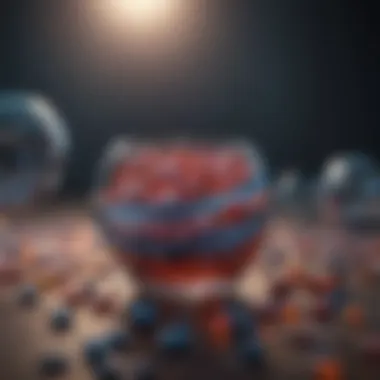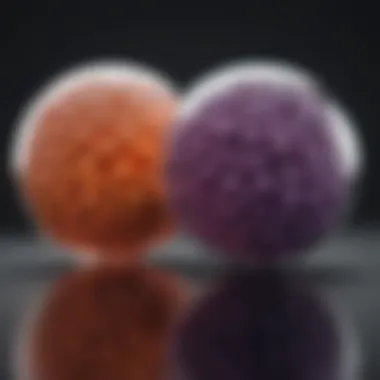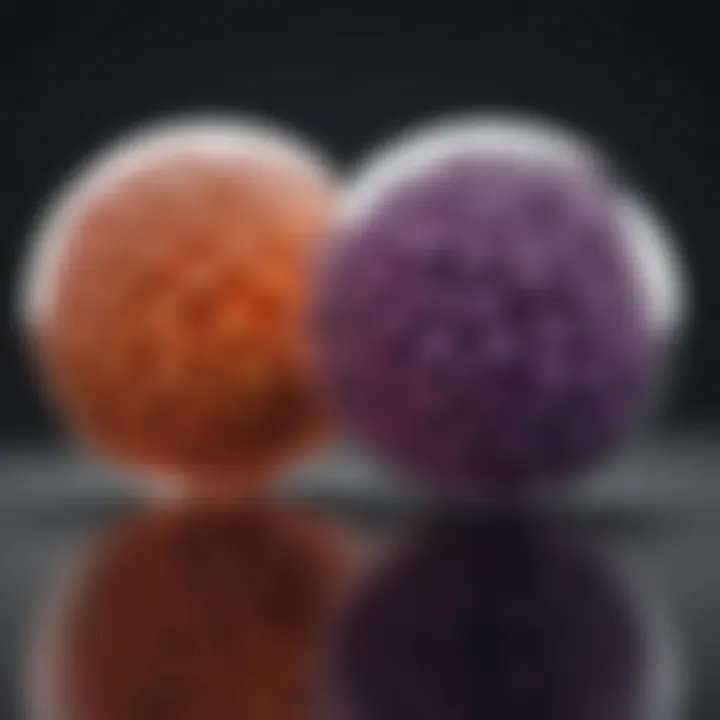Rituximab Biosimilars: Development and Implications


Background and Context
Rituximab is a monoclonal antibody used primarily in the treatment of certain types of cancers and autoimmune diseases. The drug was first approved by the FDA in 1997 for the treatment of non-Hodgkin lymphoma. Over the years, its effectiveness and scope of use expanded, paving way for the development of biosimilars. These biosimilars are biologic medical products highly similar to an already approved reference product, in this case, rituximab. As the market moves towards integration of biosimilars, understanding the background of this transition is essential.
The historical significance of rituximab lies not only in its therapeutic applications but also in its impact on treatment protocols and patient outcomes. The introduction of rituximab biosimilars aims to enhance accessibility and affordability for patients who require such therapies. With numerous health systems around the world facing financial constraints, the emergence of biosimilars provides an opportunity to alleviate economic pressures without compromising treatment quality. As the demand for biologics grows globally, biosimilars like those for rituximab are increasingly important in ensuring sustainability in healthcare.
Key Findings and Discussion
Regulatory Aspects
The development and approval process of rituximab biosimilars is governed by stringent regulatory frameworks. Regulatory bodies, such as the European Medicines Agency (EMA) and the U.S. Food and Drug Administration (FDA), have established clear guidelins that biosimilars need to meet to gain approval.
These guidelines focus on:
- Comparative studies: Biosimilars must demonstrate similarity to the reference product in terms of safety, efficacy, and quality.
- Pharmacokinetics and pharmacodynamics: Data on how the biosimilar behaves in the body must support its equivalence to the original drug.
- Post-marketing surveillance: Ongoing monitoring is essential to assess long-term effects and effectiveness.
Current Market Trends
The market for rituximab biosimilars is evolving. As of now, various biosimilars have entered the market, each developing its market share.
"The robust market for rituximab biosimilars underscores a shift towards cost-effective solutions without sacrificing clinical integrity."
Many healthcare providers and patients view these products as credible alternatives to the original rituximab. However, there remain continued hesitations and challenges in the uptake of biosimilars:
- Perception of safety: Concerns surrounding the efficacy and safety of biosimilars compared to reference products persist.
- Education: There is a demand for healthcare professional training to properly prescribe and manage treatments involving biosimilars.
Future Directions
Future directions for rituximab biosimilars will likely include advances in research focused on comparative effectiveness studies and broadened indications for use. Companies are expected to invest in clinical trials to provide robust data addressing specific diseases, which could lead to enhanced confidence in biosimilar therapies. Furthermore, as more healthcare providers become accustomed to using biosimilars, the adoption rates are expected to increase, leading to a more integrated approach in clinical practice.
In summary, understanding the comprehensive landscape of rituximab biosimilars is crucial. As the market continues to expand, ongoing education and monitoring will play pivotal roles in ensuring that healthcare professionals feel equipped to integrate these advanced therapies responsibly into patient care.
Foreword to Rituximab and Its Role in Treatment
Rituximab, a monoclonal antibody, has gained significant attention in the treatment of various hematological malignancies and autoimmune diseases. This section serves as a crucial entry point into the broader discussion about biosimilars, specifically rituximab biosimilars. Understanding the role of rituximab is essential not only for grasping the evolution of treatment options but also for evaluating the implications of introducing biosimilars into clinical practice.
Historical Development of Rituximab
Rituximab was first approved by the U.S. Food and Drug Administration (FDA) in 1997 for the treatment of certain types of non-Hodgkin lymphoma. Its introduction marked a pivotal shift in cancer therapy, as it represented one of the first monoclonal antibodies used in oncology. The initial approval was based on the drug's ability to selectively target the CD20 antigen found on the surface of B-cells, ultimately leading to cell lysis and a decrease in tumor size. Over the years, its indications expanded to include diseases such as rheumatoid arthritis and chronic lymphocytic leukemia.
The development of rituximab was a result of extensive research into monoclonal antibodies, spurred by advances in biotechnology. Its success has influenced the development of other similar therapies within the realm of monoclonal antibodies. As the drug's clinical usage grew, so did considerations around biosimilar alternatives. This leads to vital discussions about the potential benefits and challenges of integrating rituximab biosimilars into existing treatment paradigms.
Mechanism of Action
Rituximab functions mainly by binding to the CD20 antigen on B-lymphocytes. This interaction is instrumental because CD20 is a protein expressed on mature B-cells, making it an ideal target for treatment. Once rituximab binds to CD20, it activates the immune response, leading to several outcomes that are critical in the treatment context.
- Cell Death: As a result of its binding, it initiates cell-mediated cytotoxicity, which involves the destruction of the malignant B-cells.
- Complement Activation: The binding of rituximab can also activate the complement system, contributing to the lysis of targeted cells.
- Inhibition of Cell Proliferation: This therapy is effective in preventing the growth of cancerous cells and helps control disease progression.
The understanding of rituximab’s mechanism not only underscores its therapeutic potential but also illustrates why biosimilars could provide comparable efficacy and safety. As clinicians and researchers analyze rituximab biosimilars, it is this underlying mechanism that remains a pivotal point of interest for evaluating their clinical effectiveness.
Understanding Biosimilars


Biosimilars represent a crucial evolution in the pharmaceutical landscape, particularly concerning monoclonal antibodies like rituximab. Recognizing the significance of biosimilars is essential for health professionals and policymakers alike, as their introduction aims to improve treatment accessibility and reduce healthcare costs. This section will explore the definition, characteristics, and specificities of biosimilars, providing insights into their role within modern medicine.
Definition and Characteristics
Biosimilars are biological medical products that are highly similar to an already approved reference product. They contain the same active substances but may have minor differences in clinically inactive components. This definition highlights crucial aspects that differentiate biosimilars from traditional drugs.
The key characteristics of biosimilars include:
- Complexity of Production: Biosimilars are derived from living organisms and have a complex structure. Their manufacturing involves intricate processes that can lead to variations which are not clinically significant but require stringent regulatory testing.
- Demonstrated Similarity: All biosimilars must demonstrate similarity in terms of efficacy, safety, and immunogenicity to the reference product. This ensures that patients receiving biosimilars experience similar therapeutic benefits to those receiving the original product.
- Rigorous Evaluation: Regulatory authorities such as the European Medicines Agency and the U.S. Food and Drug Administration require extensive comparative studies to prove that the biosimilar matches the reference in terms of quality, safety, and effectiveness.
The significance of these characteristics cannot be overstated. They ensure that biosimilars can be integrated into existing treatment regimens without compromising patient care.
Differentiation from Generics
The term "generic" often creates confusion when discussing biosimilars. While both are considered alternatives to original branded medicines, their pathways to market and regulatory requirements are notably different.
- Complexity Differences: Generics are typically small molecule drugs with a straightforward chemical structure. In contrast, biosimilars involve larger, more complex biological products that are sensitive to manufacturing processes.
- Clinical Testing Requirements: Generics may bypass extensive clinical trials if they can demonstrate bioequivalence to their counterpart. Biosimilars, however, must undergo a more rigorous process to ensure their similarity to reference products. This generally includes clinical trials to evaluate safety and efficacy.
- Interchangeability: In some regions, generics can be substituted automatically for their corresponding brand without physician approval. For biosimilars, the rules can vary significantly, and it may be necessary for a medical professional to prescribe a specific biosimilar rather than allowing automatic substitution.
Overall, distinct regulatory pathways and characteristics underscore the complexity of biosimilars compared to generics. Understanding these differences is vital for healthcare providers and patients, as it affects treatment decisions and policy discussions.
Understanding the differentiation of biosimilars from generics is key for patients, as it provides insight into treatment options and health outcomes.
Regulatory Landscape for Rituximab Biosimilars
The regulatory landscape for rituximab biosimilars holds significant importance in understanding their place in modern medicine. This framework not only ensures patient safety and efficacy but also facilitates market competition and affordability. Regulatory agencies develop rigorous standards that help in the approval of biosimilars, distinguishing them from their reference biologics. Being aware of these regulations is essential for healthcare practitioners, researchers, and policymakers, as it directly influences treatment choices and healthcare costs.
Regulatory processes aim to create a system that assures quality and efficacy of biosimilars through comprehensive evaluation. This fosters confidence among healthcare professionals and patients alike. As the demand for cost-effective therapies increases, having a solid regulatory foundation for rituximab biosimilars becomes essential to support sustainable healthcare practices.
Approval Processes in Different Regions
The approval processes for rituximab biosimilars vary significantly across different regions. Regulatory authorities, such as the U.S. Food and Drug Administration (FDA) and the European Medicines Agency (EMA), have distinct pathways for biosimilar evaluation.
- United States: The FDA employs a rigorous process that includes a thorough review of clinical data and comparison to the reference product. The agency emphasizes the need for evidence demonstrating that the biosimilar is highly similar in terms of safety, purity, and potency.
- Europe: The EMA takes a collaborative approach, often allowing for dialogue between the agency and applicants prior to submission. This helps in addressing potential hurdles early on. The European framework is relatively advanced in its acceptance of biosimilars, offering a clearer pathway for approval.
- Asia: Countries like Japan and India are rapidly evolving their regulatory processes for biosimilars. Japan has implemented guidelines that require all approved biosimilars to show clinical effectiveness akin to that of the reference drug. Meanwhile, India has established its own set of regulations, which are more nascent but show promise in increasing the number of available biosimilars.
Understanding these processes is crucial for stakeholders, as differences can impact the availability and timely access of rituximab biosimilars in various markets.
Guidelines from Regulatory Authorities
Guidelines from regulatory authorities shape the development and approval of rituximab biosimilars. These directives outline testing requirements, quality standards, and clinical trial protocols.
- FDA Guidelines: The FDA’s 2015 guidance document emphasizes the need for comparative studies that focus on the pharmacokinetics and pharmacodynamics of the biosimilar versus the originator. This approach is vital for establishing biosimilarity.
- EMA Guidelines: The EMA has developed a comprehensive set of guidelines that cover the entire development process of biosimilars. They expect exhaustive data on quality, non-clinical, and clinical aspects to support an application. The emphasis on a risk-based approach allows companies to tailor their submissions based on specific biosimilar characteristics.
Regulatory guidelines are pivotal, as they ensure that biosimilars meet the stringent safety and efficacy standards required for therapeutic use.
- WHO Guidelines: The World Health Organization also provides important guidance on biosimilars, stressing the need for thorough analytical studies and clinical data to support claims of similarity.
In summary, these guidelines are not merely bureaucratic requirements but serve as essential frameworks that foster innovation and ensure patient safety, ultimately contributing to the credibility of rituximab biosimilars in the medical community.
Efficacy and Safety of Rituximab Biosimilars
The efficacy and safety of rituximab biosimilars is a critical subject, particularly due to their increasing use in clinical settings. Understanding how these biosimilars perform compared to their reference product, Rituxan, affects treatment choices for various conditions, including certain cancers and autoimmune disorders. There are several elements to consider when discussing the efficacy and safety of these products specifically.
Clinical Study Comparisons


Clinical studies play an essential role in assessing the efficacy of rituximab biosimilars. Several phase III trials have successfully compared biosimilars with the reference product. These studies generally indicate comparable efficacy in terms of overall response rates, progression-free survival, and overall survival. For example, studies comparing CT-P10 and Rituxan showcased nearly identical outcomes in patients with non-Hodgkin lymphoma.
Nonetheless, while overall efficacy is demonstrated, nuances do exist that merit further exploration. Factors such as patient demographics, disease state, and prior treatments can affect outcomes. Additionally, some studies have reported slightly varied side effect profiles, leading to questions about safety.
Post-marketing Surveillance Data
Post-marketing surveillance formally monitors the safety and efficacy of drugs once they are available on the market. This data is essential for understanding the long-term effects and real-world performance of rituximab biosimilars. The importance of this data cannot be overstated, as it captures a wider population than clinical trials often can.
In the case of rituximab biosimilars, available post-marketing reports have shown a range of safety profiles that are mostly consistent with those of the originator. Serious adverse events are reported with similar frequencies. However, some patients report various mild adverse reactions after switching from reference products to biosimilars. This can lead to hesitance concerning the adoption of biosimilars, as patient experiences vary, influenced by factors such as communication from healthcare providers and previous treatment history.
In summary, while the efficacy of rituximab biosimilars aligns closely with that of the reference product based on clinical trials, ongoing post-marketing surveillance provides necessary oversight to ensure their continued safety in broader population usage. Understanding these dynamics is vital for physicians and patients alike.
Cost-Effectiveness and Market Dynamics
The topic of cost-effectiveness and market dynamics is vital when exploring rituximab biosimilars. Understanding how these biologics fit into the healthcare economy helps stakeholders navigate the complexities of treatment options. Cost considerations do not only influence patient access to medications but also affect healthcare budgets and policy decisions globally. The impact of biosimilars extends beyond price reductions; they challenge the monopolistic structures often found in pharmaceutical markets, which can enhance competition and foster broader healthcare access.
Economic Impact of Biosimilars
Biosimilars aim to replicate the efficacy and safety profile of existing biologic medications, such as rituximab. The economic impact of biosimilars is multifaceted, affecting costs, accessibility, and innovation incentives.
- Cost Reduction: The introduction of rituximab biosimilars has potential to significantly lower treatment costs. Reports show that biosimilars can be priced as much as 20% to 40% lower than their original counterparts. This reduction holds particular importance for treatments involving chronic conditions like rheumatoid arthritis and certain cancers where long-term therapy is required.
- Access to Treatment: Lower prices can improve patient access to necessary treatments. This broadened access can lead to better health outcomes for populations that previously could not afford these medications. By making treatment more affordable, healthcare systems can potentially reduce overall costs associated with hospitalizations and disease complications.
- Increased Competition: The entry of biosimilars into the market fosters competition. Increased competition can lead to further price reductions and innovations in drug development. The economic landscape shifts as original manufacturers may respond by reducing prices or enhancing value in their products.
Statistics suggest that the biosimilar market is projected to grow globally, emphasizing the profound economic implications. According to a report from the Global Biosimilars Forum, the market for biosimilars is expected to reach billions in the next few years, underscoring the transformative potential of these medicines.
Overall, the economic impact of biosimilars like rituximab extends beyond mere cost savings. It represents a shift toward increased accessibility, improved patient outcomes, and enhanced market vitality.
Price Trends in Biosimilar Markets
Price trends within biosimilar markets have shown a distinct trajectory since their introduction. Tracking these trends helps to understand the evolving landscape.
- Initial Launch Prices: Most biosimilars are launched at a discount compared to their reference products. For example, the first rituximab biosimilars entered the market at a price significantly lower than the original Rituxan. This pricing strategy is crucial to gain market share quickly.
- Erosion of Prices Over Time: As more biosimilars are approved, the prices tend to decrease further. Increased competition leads to a gradual decline in costs, which can result in lower out-of-pocket expenses for patients and insurance systems alike.
- Market Dynamics: Factors such as patent expirations and the pace of new biosimilar approvals can create fluctuations in pricing. Regulatory changes can also affect availability and pricing strategies, impacting overall market dynamics.
Patient Perspectives and Acceptance
Understanding patient perspectives and acceptance of rituximab biosimilars is critical in shaping their successful integration into clinical practice. Patients play an active role in their treatment decisions, and their trust in biosimilars influences adherence to therapy. When patients feel confident about the medications they will take, it can lead to improved health outcomes and a better overall experience within the healthcare system.
Surveys on Patient Trust in Biosimilars
Recent surveys provide insights into the levels of trust that patients have in biosimilars compared to their reference products. Many studies indicate a significant variability in patient belief about the safety and efficacy of biosimilars.
Here are some key findings from these surveys:
- General Awareness: Many patients are still unaware or misinformed about what biosimilars are and how they function.
- Trust Levels: Trust in biosimilars correlates closely with the perceived reputation of the pharmaceutical companies producing them. Companies with established histories in the market often have higher trust rates.
- Educational Initiatives: Greater emphasis on patient education regarding biosimilars can enhance confidence. Patients that received information from healthcare providers about biosimilars tend to show more trust in using these medications.
- Side Effects Concerns: Some patients express fears regarding potential side effects or a perceived lesser efficacy of biosimilars, which can be mitigated through proper counseling.
Influence of Physician Recommendations
Physician recommendations have a profound impact on patient acceptance of biosimilars. Healthcare practitioners serve as primary sources of information about treatment options. Their views can sway patient opinions and beliefs about the safety and effectiveness of rituximab biosimilars.
Factors influencing physician recommendations include:
- Experience with Biosimilars: Physicians who have successfully prescribed biosimilars may advocate more strongly for their use.
- Clinical Guidelines: Adherence to established clinical guidelines also informs a physician’s recommendation, which can instill confidence in patients.
- Personal Interaction: The manner in which physicians communicate the benefits and risks of using biosimilars greatly affects patient acceptance. Open dialogues can foster trust.
Ultimately, patient perspectives and acceptance are crucial components that impact the success of rituximab biosimilars in real-world settings. Ongoing efforts to educate both patients and physicians are needed to enhance understanding and confidence in these innovative therapies.


"Trust in healthcare is built not only on the efficacy of treatment but also on the quality of information shared across providers and patients."
Challenges in Adoption of Rituximab Biosimilars
The adoption of rituximab biosimilars presents several challenges that impact their integration into clinical practice. These challenges are crucial in understanding the overall acceptance of biosimilars by healthcare professionals and patients. Addressing legal and distribution barriers is essential for the successful incorporation of these therapeutics into standard treatment protocols. Recognizing these challenges also highlights the ongoing efforts to improve accessibility and affordability of biosimilars, which can ultimately benefit patients and the healthcare system alike.
Legal Barriers and Patent Issues
Legal barriers remain a prominent challenge in the adoption of rituximab biosimilars. These issues primarily stem from complex patent landscapes surrounding the original rituximab product, marketed as Rituxan by Genentech. Even after the primary patent expiry, several additional patents can obstruct the introduction of biosimilars. These secondary patents protect various formulations, methods of use, or delivery mechanisms.
The implications of these legal challenges are significant. They contribute to delays in market entry for biosimilars. Some companies may face litigation over patent infringement, automatically prolonging the time taken for these products to reach the patients who need them. Furthermore, companies often invest substantial resources in legal battles, diverting funds that could otherwise enhance research and development. Understanding these legal landscapes is critical for anyone involved in the biopharmaceutical industry, as it shapes the strategic decisions for companies looking to invest in biosimilar development.
"Legal clarity and streamlined processes can facilitate faster adoption of biosimilars, ultimately benefiting patient care.”
Access and Distribution Constraints
Access and distribution constraints further complicate the adoption of rituximab biosimilars. These barriers encompass several logistical and systemic factors that can inhibit effective market penetration. First, geographical disparities often mean that patients in less urbanized or less developed regions do not have adequate access to these biosimilars. The distribution networks may be inefficient or lack comprehensive coverage, leading patients to continue using more expensive branded medications out of necessity.
Additionally, pricing strategies can impact access. While biosimilars generally have a lower cost than their reference products, the extent of price reduction can vary across different markets. If prices do not significantly undercut those of the original rituximab, healthcare providers may not readily switch patients to biosimilars, especially if they perceive that the branded option remains a safe and effective choice.
To enhance access, stakeholders must adopt strategic measures such as improving distribution channels and offering educational initiatives. These efforts can promote awareness of rituximab biosimilars among healthcare providers and patients, and ultimately align public health objectives with market interests.
Current Research and Future Directions
Rituximab biosimilars are increasingly significant in the realm of oncology and autoimmune diseases. Understanding the current research and future directions helps stakeholders grasp the evolving landscape of biopharmaceuticals. Ongoing studies and innovations contribute to efficacy, safety, and accessibility. This section highlights essential elements, benefits, and considerations that shape the future of rituximab biosimilars.
Emerging Developments in Biosimilar Research
Advancements in biosimilar research are mostly promising. Researchers focus on refining the processes to create more effective and affordable drugs. Some noteworthy developments include:
- Advanced Manufacturing Techniques: Novel biologic production methods enhance yield and purity. Techniques such as high-throughput screening allow for quicker iteration and optimization of biosimilar processes.
- Analytical Technologies: Improved analytical methods facilitate better characterization of biosimilars. Techniques like mass spectrometry and chromatography provide insights into structural integrity and biological activity.
- Clinical Trials: Ongoing trials are essential to establish safety and efficacy profiles for new biosimilars. Comprehensive study designs, including head-to-head comparisons against reference products, are paramount.
These factors reflect the commitment to not just replication, but also innovation in the sphere of biosimilars.
Potential for New Indications
The flexibility of rituximab biosimilars extends their potential beyond existing applications. Researchers are exploring various avenues:
- Combination Therapies: Studies examine the role of rituximab biosimilars in combination with other therapies. This approach may enhance treatment effectiveness in cancers, such as diffuse large B-cell lymphoma, and autoimmune diseases like rheumatoid arthritis.
- Adjuvant Treatments: There is potential for these biosimilars in earlier stages of treatment. Their application might increase treatment success rates and reduce overall healthcare costs.
- Pediatric Applications: Given growing evidence supporting the use of rituximab in children, further research is sought to evaluate the safety and effectiveness of biosimilars in pediatric populations.
As the body of evidence continues to grow, the adaptability of rituximab biosimilars suggests a bright future for both clinical practice and patient outcomes. In summary, continuous research opens new doors, further solidifying the role of rituximab biosimilars in modern medicine.
The exploration of biosimilars does not merely reflect an increase in options; it signifies advances in treatment paradigms that benefit diverse patient populations.
Finale
Rituximab biosimilars represent a significant advancement in the field of biopharmaceuticals. Understanding the insights gained throughout this article is essential for several reasons. First, it highlights the evolving landscape of biosimilars and their increasing role in therapeutic settings. Knowledge of their efficacy, safety, and cost-effectiveness can aid healthcare professionals in making informed decisions for their patients.
Summarizing Key Findings
In summarizing key findings, it is evident that rituximab biosimilars have undergone rigorous testing to ensure their non-inferiority to original rituximab. Clinical studies show comparable effectiveness, which is crucial for patients with conditions such as non-Hodgkin lymphoma and rheumatoid arthritis. The data from post-marketing surveillance supports these findings, indicating similar safety profiles.
Moreover, the article underscored the regulatory frameworks that govern the approval of biosimilars. For instance, the FDA's complete pathways provide a structure that enhances patient access to therapies while ensuring safety. Each country's regulatory body, such as the EMA in Europe, serves to enforce strict guidelines that further validate these products.
Final Thoughts on Rituximab Biosimilars
The discussions on patient perspectives indicate a mixed response towards biosimilars, often influenced by physician recommendations. Educating healthcare providers and patients about the benefits and risks associated with these treatments will be crucial moving forward.
Understanding the potential for new indications also sparks interest in future research endeavors. Uncovering more applications could expand the therapeutic reach of rituximab biosimilars considerably. The collective insights from this article highlight the importance of ongoing research and discussion within the healthcare community. It strengthens the case for biosimilars as viable alternatives, ultimately benefiting patients and healthcare systems.







